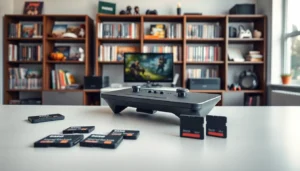Table of Contents
ToggleThe Steam Deck has taken the gaming world by storm, turning heads and raising eyebrows with its portable power. But what if it could do even more? Enter the realm of emulation, where nostalgia meets innovation. Imagine playing all your favorite classics from retro consoles right in the palm of your hand. It’s like having a time machine that fits in your backpack!
Overview of Steam Deck Emulation
Steam Deck emulation allows users to run games from various consoles on the handheld. Emulators mimic the hardware of classic systems, making it possible to play titles from consoles like Nintendo 64, PlayStation, and Sega Genesis. Gaming enthusiasts appreciate this flexibility, as it offers a chance to experience beloved games that may be unavailable on modern systems.
Installation of emulators on the Steam Deck is straightforward. Users often rely on popular emulation software, such as Yuzu for Nintendo Switch or PCSX2 for PlayStation 2, which provides compatibility with numerous games. Configuration usually involves setting up controls, video settings, and directories for game files, ensuring optimal performance on the device.
Performance remains a critical factor for successful emulation. The Steam Deck’s AMD APU provides enough power to handle a wide array of games. Many users report smooth gameplay experiences with reduced lag, enhancing overall enjoyment. The dedicated community continuously develops performance tweaks and optimization guides, further improving the emulation process.
Legal considerations play an important role in emulation, as users must navigate copyright laws regarding game ROMs. Downloading games or software without ownership is unlawful. Instead, owners of original titles can create ROMs for personal use, preserving their gaming libraries in a digital format.
Many gamers find Steam Deck emulation a nostalgic escape. Classic titles, once limited to outdated hardware, become accessible on a modern platform. This capability expands the gaming library, making the Steam Deck not just a cutting-edge device but also a nostalgic portal for gamers seeking to relive their favorite moments.
Benefits of Steam Deck Emulation

Steam Deck emulation offers gamers unique advantages, enhancing their gameplay and expanding their collection.
Enhanced Gaming Experience
Users can enjoy classic games with improved graphics and performance on the Steam Deck. Emulators often include graphic enhancements, such as higher resolutions and better frame rates. Nostalgic gamers can experience these titles in a way that feels fresh and exciting. Control customization options provide additional flexibility, allowing players to set up controls as they prefer. It’s possible to enjoy titles that originally had limitations, transforming the overall gaming experience.
Access to a Wider Library
Steam Deck emulation opens doors to an extensive library of games across various platforms. Retro consoles like Nintendo 64, PlayStation, and Sega Genesis provide a wealth of titles that are often overlooked. With emulators readily available, it’s easy to explore numerous genres and eras of gaming. Players can revisit beloved classics alongside lesser-known gems, significantly expanding their gaming options. This accessibility fosters a richer connection with gaming history and provides entertainment beyond the current market offerings.
Getting Started with Steam Deck Emulation
Setting up Steam Deck emulation involves selecting the right software and following a straightforward installation process. Users can quickly dive into classic gaming with the appropriate tools.
Required Software and Tools
Emulators serve as the foundation for running classic games on the Steam Deck. Popular options include Yuzu for Nintendo Switch titles and PCSX2 for PlayStation 2 games. Additional software like RetroArch provides a versatile platform for various systems, enhancing compatibility. Users should also consider installing a frontend like Steam ROM Manager to manage their games effectively. Specific tools may enhance performance, such as Proton GE, which optimizes compatibility with Windows games.
Installation Process
Installing an emulator is user-friendly on the Steam Deck. Start by accessing the Discover Software Center, where users can search for and install their chosen emulator. Alternatively, users can download applications directly from developer websites. Once installed, users must configure the emulator settings, adjusting visual and control options to their preferences. Adding game ROMs follows, requiring careful attention to legal guidelines. Finally, users can launch the emulator through their console interface, making classic games accessible with just a few clicks.
Best Emulators for Steam Deck
Emulators enhance the gaming experience on the Steam Deck, providing access to classic titles. Users can explore various popular emulator options and performance comparisons to optimize gameplay.
Popular Emulator Options
Yuzu stands as a top choice for Nintendo Switch games, offering good compatibility with many titles. PCSX2, known for PlayStation 2 games, delivers reliable performance and a vast game library. RetroArch aggregates multiple emulators in one platform, making it versatile for various systems. For Sega Genesis games, Kega Fusion provides excellent emulation quality. Additionally, Dolphin allows GameCube and Wii titles to shine on the Steam Deck, catering to retro fans. Launching these emulators involves simple installation from the Discover Software Center or direct downloads.
Performance Comparisons
Performance varies significantly between emulators on the Steam Deck. Yuzu generally runs well for many Nintendo Switch games, achieving playable frame rates with proper configuration. PCSX2 often requires adjustments to graphic settings for optimal results on demanding titles. RetroArch can provide smooth gameplay thanks to its broad support across systems, yet performance depends on the specific core being used. Dolphin frequently features high-quality graphics and stable frame rates, allowing for enjoyable gaming sessions. Users can experiment with settings in each emulator for the best experience, ensuring high performance across the board.
Tips for Optimizing Emulation on Steam Deck
Optimizing settings for emulation on the Steam Deck enhances performance and gameplay. Tuning certain parameters ensures smoother experiences while running classic games.
Configuring Settings
Adjusting graphical settings plays a crucial role in optimizing emulation. Increasing resolution scales up visuals but may drain performance; striking a balance is essential. Tweaking frame rate limits helps achieve smoother gameplay without overwhelming the device. Configuring the GPU for the emulator also enhances compatibility with older titles. Emulators often include specific settings tailored for different consoles; utilizing these can maximize performance. Exploring audio settings improves sound quality, further enhancing immersion. Lastly, creating custom profiles for various games allows tailored configurations and optimal performance.
Troubleshooting Common Issues
Addressing common emulation issues can save valuable gaming time. Performance drops during gameplay might signal resource overload; reducing graphical settings often resolves this. Incompatibilities can arise with specific games; researching emulator-specific forums may unveil effective solutions. Missing audio or visual glitches indicate outdated emulator versions; ensuring updates are installed often fixes these problems. Crashes during startup typically suggest misconfigured settings or corrupted ROM files. Verifying file integrity or reconfiguring initial settings may solve these issues. Configuring input settings helps with unresponsive controllers, improving overall gameplay experience.
The Steam Deck opens up a world of possibilities for gamers seeking to relive classic experiences. Its robust hardware and user-friendly emulation capabilities make it an ideal platform for exploring beloved titles from various consoles. With a dedicated community continually refining performance and compatibility, players can expect an enjoyable and nostalgic gaming journey.
By navigating the legal landscape responsibly and optimizing emulator settings, users can fully embrace the rich history of gaming. The Steam Deck not only enhances access to a diverse library but also fosters deeper connections with the games that shaped their childhoods. As technology evolves, the potential for even greater emulation experiences on the Steam Deck is promising.







